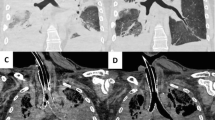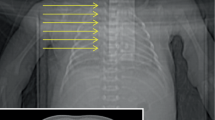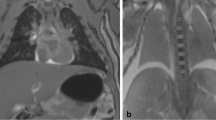Abstract
Objectives
Ventilated postmortem computed tomography (vPMCT) is associated with improved pulmonary imaging compared to standard PMCT in adults. We aimed to evaluate the feasibility of performing ventilated PMCT in children.
Methods
Postmortem thoracic CT was performed before (PMCT) and after ventilation (vPMCT). We used a range of mouthpieces, including endotracheal tubes, bag and mask and laryngeal mask airway (LMA). Hounsfield units of the lungs at PMCT were measured for normal and abnormal lung areas, before and after ventilation. All patients underwent full conventional autopsy and histology.
Results
Twelve patients underwent ventilated PMCT, median age 52 days (range 3–304 days). Ventilated PMCT provided diagnostic lung images in all 12 cases, compared to only three unventilated PMCT examinations (p < 0.005). In all cases, ventilated PMCT improved the image quality of aerated lungs irrespective of the method used. Average lung Hounsfield units decreased significantly with ventilation from pre-vPMCT values (−134.1 ± 215.1 vs post-vPMCT −531.8 ± 190.1; p < 0.001). LMA with continuous positive pressure ventilation subjectively provided the best results.
Conclusion
Ventilated PMCT significantly improves lung aeration in children and can aid recognition of areas of abnormality in paediatric lungs. Such advances will improve accuracy and uptake of imaging-assisted autopsies in children.





Similar content being viewed by others
Abbreviations
- HU:
-
Hounsfield units
- LMA:
-
Laryngeal mask airway
- PEEP:
-
Positive end expiratory pressure
- (PM)MR:
-
(Postmortem) magnetic resonance imaging
- vPMCT:
-
Ventilated postmortem computed tomography
References
Thayyil S, Sebire NJ, Chitty LS, Wade A, Chong WK, for the MARIAS collaborative group et al (2013) Post-mortem MRI versus conventional autopsy in fetuses and children: a prospective validation study. Lancet 382:223–233
Arthurs OJ, Thayyil S, Olsen OE, Addison S, Wade A, Jones R, Norman W, Scott RJ, Robertson NJ, Taylor AM, Chitty LS, Sebire NJ, Owens CM (2014) Diagnostic accuracy of post-mortem MRI for thoracic abnormalities in fetuses and children. Eur Radiol 24:2876–2884
Germerott T, Preiss US, Ebert LC et al (2010) A new approach in virtopsy: postmortem ventilation in multislice computed tomography. Legal Med (Tokyo) 12:276–279
Germerott T, Flach PM, Preiss US, Ross SG, Thali MJ (2012) Postmortem ventilation: a new method for improved detection of pulmonary pathologies in forensic imaging. Legal Med (Tokyo) 14:223–228
Robinson C, Biggs MJ, Amoroso J, Pakkal M, Morgan B, Rutty GN (2014) Post-mortem computed tomography ventilation; simulating breath holding. Int J Legal Med 128:139–146
Rutty GN, Biggs MJP, Brough A, Robinson C, Mistry R, Amoroso J, Deshpande A, Morgan B (2015) Ventilated post-mortem computed tomography through the use of a definitive airway. Int J Legal Med 129(2):325–334, IJLM-D-14-00316
Arthurs OJ, Taylor AM, Sebire NJ (2013) The less invasive perinatal autopsy: current status and future directions. Fetal Matern Med Rev 24:45–59
Royal College of Pathologists Working Party on the Autopsy (2006) Guidelines on autopsy practice: scenario 9: stillborn infant (singleton). June 2006. http://www.rcpath.org/Resources/RCPath/ Migrated_Resources/Documents/G/G001Autopsy-Stillbirths-Jun06.pdf. Accessed Jan 2015
Sebire NJ, Weber MA, Thayyil S, Mushtaq I, Taylor A, Chitty LS (2012) Minimally invasive perinatal autopsies using magnetic resonance imaging and endoscopic postmortem examination (“keyhole autopsy”): feasibility and initial experience. J Matern Fetal Neonatal Med 25:513–518
Shiotani S, Kobayashi T, Hayakawa H, Kikuchi K, Kohno M (2011) Postmortem pulmonary edema: a comparison between immediate and delayed postmortem computed tomography. Legal Med (Tokyo) 13:151–155
Hyodoh H, Shimizu J, Watanabe S, Okazaki S, Mizuo K, Inoue H (2015) Time-related course of pleural space fluid collection and pulmonary aeration on postmortem computed tomography (PMCT). Legal Med (Tokyo). doi:10.1016/j.legalmed.2015.01.002
Proisy M, Marchand AJ, Loget P et al (2013) Whole-body post-mortem computed tomography compared with autopsy in the investigation of unexpected death in infants and children. Eur Radiol 23:1711–1719
Noda Y, Yoshimura K, Tsuji S et al (2013) Postmortem computed tomography imaging in the investigation of nontraumatic death in infants and children. Biomed Res Int 2013:327903
Sieswerda-Hoogendoorn T, Soerdjbalie-Maikoe V, de Bakker H, van Rijn RR (2014) Postmortem CT compared to autopsy in children; concordance in a forensic setting. Int J Legal Med 128:957–965
Acknowledgments
OA is funded by an NIHR Clinician Scientist AWARD, and NJS is funded by an NIHR Senior Investigator award, Great Ormond Street Children’s Charity and the Great Ormond Street Hospital Biomedical Research Centre.
This article presents independent research funded by the National Institute for Health Research (NIHR) and supported by the Great Ormond Street Hospital Biomedical Research Centre. The views expressed are those of the author(s) and not necessarily those of the NHS, the NIHR or the Department of Health.
Ethical standards
This study complies with the current laws and ethical standards required in the UK.
Conflict of interest
The authors declare that they have no conflicts of interest.
Author information
Authors and Affiliations
Corresponding author
Rights and permissions
About this article
Cite this article
Arthurs, O.J., Guy, A., Kiho, L. et al. Ventilated postmortem computed tomography in children: feasibility and initial experience. Int J Legal Med 129, 1113–1120 (2015). https://doi.org/10.1007/s00414-015-1189-z
Received:
Accepted:
Published:
Issue Date:
DOI: https://doi.org/10.1007/s00414-015-1189-z




